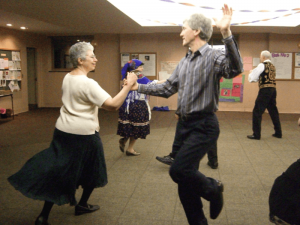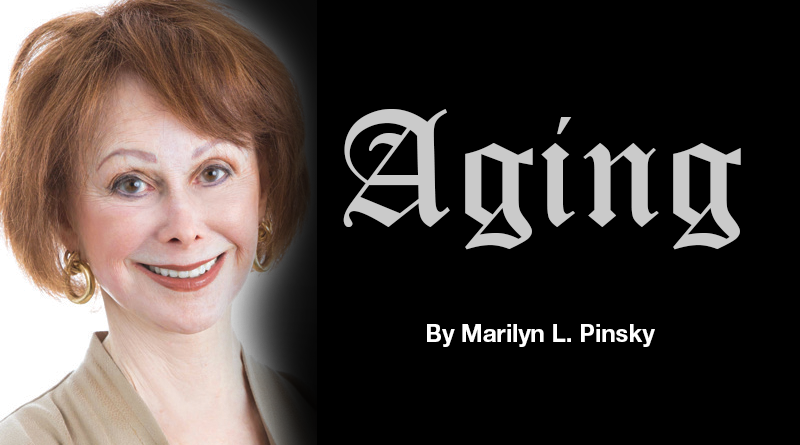Dance the Night Away
Folk dance group good for health, inspiration
By Marilyn L. Pinsky

Do you tap your toes when the music starts? Do you wish you could run out to the dance floor alone and be part of a group? Do you want to meet other people who feel the same way? The answer?
Folk dancing.
When our generation was young, folk dancing was a “thing.” It might not have been your thing at the time, maybe rock ‘n’ roll was, but it is a form of dance that has stood the test of time and geography, and now might be when you should give it a try.
Except for ethnic festivals, there are not that many opportunities to folk dance, but there is a group that keeps the traditions from many countries alive, and its members truly welcome newcomers to their group.
You would not only be doing yourself a favor, you would be helping to keep a tradition alive in our community.
The Syracuse International Folk Dancers website says, “If you love to dance or you love music, you’ll love folk dance. We do Israeli, Balkan, Romanian, Greek, Turkish, Scandinavian but mostly Eastern European dances.”
What if you haven’t danced before?
“It doesn’t matter, all you have to do is want to dance. There are people at all levels of dance, all walks of life and absolute beginners also. This is not a performing group; it is truly just for fun,” the website adds.
Karen and Bill Havens and Carmen Giunta function as the organizers for SIFD and would love to have more people join the group.
To join, “just go to the website http://sifd.kbhavens.com where you’ll also get a sense of the group from pictures posted there.
I mentioned that I am a klutz and could not imagine learning the dances, most of which are done in a circle.
First is to learn the steps, and then the style follows, so being graceful is not that essential. If everyone is going left, you go left,” explained Bill.
The group started at Syracuse University in the 1950s and then moved to its present location at the First Unitarian Universalist Church on Waring Road in Syracuse.
“I liked the idea of ethnic dancing that I saw when attending the Greek Fest, but didn’t feel there was any place where I could dance,” Karen said. “Then I saw an ad in a newspaper for this group and I just turned up. I hadn’t danced since elementary school but after a few times, you just pick up the steps.”
“There are hundreds of dances, and you do the ones you want,” she said. “We go to dance camps all over to learn new dances and bring them back here to teach everyone else.
“We were recently in Toronto where we have a friend who is 104 that we danced with there. It is really the most fun you can have while exercising. We’re often asked what to wear whatever is comfortable: sweats, tights, and comfortable clothes. Smooth bottomed shoes are best but many dance in sneakers and there are dance socks that can go over regular shoes,” she added.
“These types of groups are very informal,” said Bill. “We have a very anarchistic structure; whoever knows the dance and has the music for it leads a particular dance. Karen and I have danced with groups like this all over the world. In fact, we are on our way to the West Coast soon and will stop in four cities across the country to dance.”
Cohesive bunch
Giunta said there are leaders only in the sense of teaching the dances.
“We are a very friendly group. Bill is the head of the welcoming committee and he will take you under his wing. You don’t have to have danced before; you can just like to move to music and want to be social. Once you have come to the group three times, you’re hooked,” she said.
Are the dances difficult?
“There are really, really easy ones that anyone can do,” said Giunta. “But as you get more confident, you’ll want to do more difficult dances, and you can take as much time as you need to learn them.
“For dances that are more complex, you can follow along by dancing outside the circle until you feel confident enough to join in. But if you’re interested in jumping right in, someone will always be glad to teach you.”
I attended one evening and spoke with some of the dancers. Their ages range from 40 to 99-year-old dancer George Kilpatrick.
The professional backgrounds of the dancers are varied, with some retired and some still working. The night I attended, there were doctors, professors, schoolteachers, a computer programmer and two therapists.
I asked dancer Linda Land why she is so passionate about this group.
“I can be utterly exhausted but when I get to the group and hear the first dance, it has an astonishing effect. The music is so compelling and soothing that two hours later, I am totally rested from dancing,” she said.
Barbara Cargo, who taught pre-K at Franklin School Elementary in Syracuse and Syracuse University, and Jerry Cargo, a retired math professor from S.U., have been dancing for 30 years. “Once you get acquainted with the music, it just lifts your spirits,” Cargo said. “If you’re a newcomer and you just keep coming, you’ll learn the dances. It is not just good exercise, but you’re doing it with wonderful people. You might feel awkward your first time but the group is so patient and welcoming and not everyone knows or does every dance.”
Todd Sullivan worked at IBM for 26 years. He knows a great deal about folk dance and frequently shares his knowledge and teaches dances.
Linda DeStefano, who is involved in animal and environmental protection issues, feels that “SIFD is important in order for me to have balance in my life. Dancing is just sheer fun.”
Jeff and Tess Freedman joined SIFD three months ago.
“We hadn’t danced for 50 years, not since we were in school,” said Jeff They are both college professors and also teach boating classes.
“Once we started dancing here, there was a robust and immediate improvement in my balance,” said Jeff. “There is something counter-intuitive in a dance that keeps your brain active and provides a great cardiovascular workout.”
The group meets Thursday nights. Generally, 8-9 p.m. is for teaching and learning dances and dancing is featured from 9-10 p.m.
There are occasionally some social activities such as a potluck supper. The first night is free and then there is a $5 fee to defray expenses.

